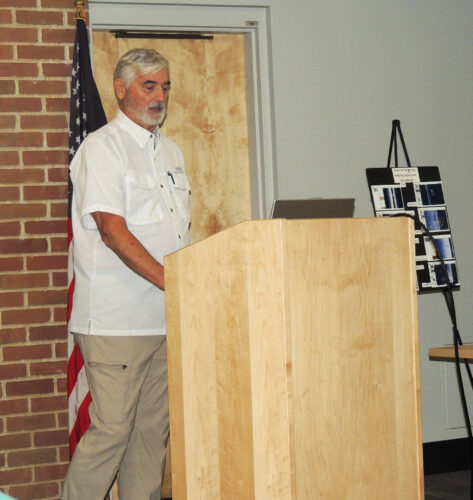Author guides audience on a tour of lighthouses

Correspondent photo / Nancilynn Gatta
Mike Wachter discusses Lake Erie Lighthouses during his talk, “Erie Lights & Lighthouse Lore” on Tuesday at the Warren Trumbull County Public Library in Warren.
Multi-floor structures that provide illumination for vessels traveling through a body of water, lighthouses were constructed of brick, cast iron, steel and concrete.
Wachter pointed out 42 lighthouses surround Lake Erie, which, according to the “Lighthouses of the Great Lakes” website, is the smallest number among the five Great Lakes.
He became interested in the buildings during a dive for shipwrecks in Lake Erie where he discovered a lighthouse on a small piece of land in the middle of nowhere.
Some of the lighthouses have not only historical significance but practicality to this day.
“Marblehead Lighthouse is the oldest continuous lighthouse on the Great Lakes. It is still active today,” he said. The tower began guiding ships around Marblehead Peninsula 203 years ago in 1822.
Wachter also discussed the styles of lighthouses. “Currently, a 60-foot neoplastic style tower in Conneaut, Ohio, built in 1921, is probably the most visible because it can be seen from 17 miles away,” Wachter said. It is a two-story building that is made of concrete but is simple in structure and color, which are characteristics of neoplastic design.
He also discussed the materials that were used to create the light to help the ships avoid obstructions.
“The Marblehead Lighthouse was originally lit using whale oil. Then, it was changed to kerosene. The only thing that was never used was natural gas. It was finally converted to electricity in 1923,” said Wachter.
The lights had to move to display different areas of the lake to help guide the ships. Wachter explained their operation in the earliest of days.
“Lighthouses, like Marblehead, South Bass and Toledo, all had rotating mounts for their lights that were run by weights. You have to crank the weight up every three hours and the weight turns the turntable for the light, which causes the light to rotate,” said Wachter.
Lighthouse keepers run the lighthouse. Their duties include running the lights every three hours. That involves taking a 5-gallon bucket of heated oil to the light, cleaning the windows daily, keeping the grounds maintained, cleaning the light daily and much more.
“There was also another job for lighthouse keepers, particularly on Lake Erie. It was a stop on the Underground Railway. Slaves would escape the South and they would be kept in lighthouses before they boarded the boat to go to freedom in Canada. The most famous is Fairport Harbor Light in Fairport, Ohio. It is now a museum. They will show you the secret room where escaped slaves stayed,” said Wachter.
Life as a lighthouse keeper is isolating and lonely. It can also be dangerous. Wachter told a joke about a Naval vessel signaling another ship to get out of its way. The response said, “I can’t Captain. I’m a lighthouse.”
“Unfortunately, the lighthouse doesn’t always win,” Wachter said as he brought up a lighthouse that was hit by a vessel. The lighthouse was made of cast iron and steel on a stone foundation.
“This is the current Erie Pierhead Light. It was built originally in 1857. In 1857, a sailing vessel managed to total it. It was rebuilt in 1858,” he said.
He also mentioned that in 1927 the Canadian Steamer, Glen Eagles, knocked the Ashtabula Lighthouse back 6 feet.
Today shifting sand on the lake is more of a detriment to the existence of the lighthouses than being struck by a vessel.
Wachter touched upon the rumors of certain lighthouses being haunted.
“There are creepy noises in the lighthouse on South Bass Island. The hired hand jumped off the cliff and the fourth keeper fell off the cliff. They say it is haunted. It is owned by the Ohio State University now and it still has creepy noises,” he said.
Today, some of the Lake Erie lighthouses are operable. Some have been used as U.S. Coast Guard stations while others are museums.
